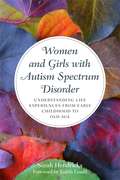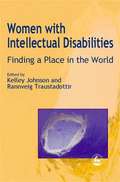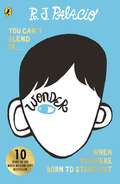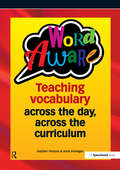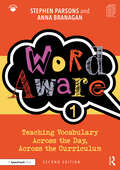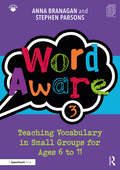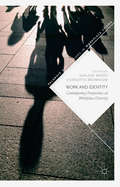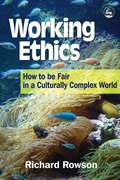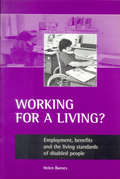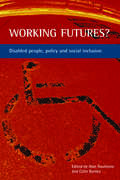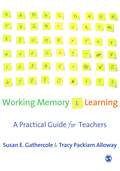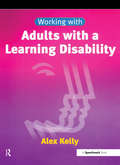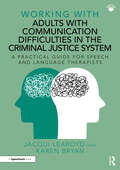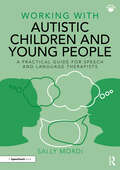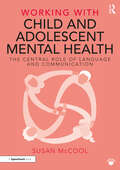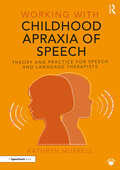- Table View
- List View
Women and Girls with Autism Spectrum Disorder: Understanding Life Experiences from Early Childhood to Old Age
by Sarah Hendrickx Judith GouldThe difference that being female makes to the diagnosis, life and experiences of a person with an Autism Spectrum Disorder (ASD) has largely gone unresearched and unreported until recently. In this book Sarah Hendrickx has collected both academic research and personal stories about girls and women on the autism spectrum to present a picture of their feelings, thoughts and experiences at each stage of their lives. Outlining how autism presents differently and can hide itself in females and what the likely impact will be for them throughout their lifespan, the book looks at how females with ASD experience diagnosis, childhood, education, adolescence, friendships, sexuality, employment, pregnancy and parenting, and aging. It will provide invaluable guidance for the professionals who support these girls and women and it will offer women with autism a guiding light in interpreting and understanding their own life experiences through the experiences of others.
Women With Intellectual Disabilities: Finding a Place in the World (PDF)
by Kelley Johnson Rannveig Traustadottir'I recommend this book to anyone engaged in working collaboratively with people with the label 'learning difficulty', particularly in women's; groups, self advocacy or rights bases/citizenship concerns. The plain English accounts are accessible, but I also found the main bulk of the text easily translatable and used it extensively in my recent research. For the women involved in this project it provided a framework of reference in which they recognized similar life events and experiences. Not only does this book fill this gap by providing a frame in which women can examine this exclusion, it also questions the marginalized position of women classified as having 'learning difficulties' in feminist and disability literature.' - Disability and Society 'This is such a good read that it is difficult to be objective about the content, criticism was suspended! It is divided into parts and each part is helpfully introduced by the editors. There is also a short straightforward description of the content at the beginning of each chapter so that women with intellectual disabilities can be included in the readership.This book gives us a valuable insight into the lives of women with learning disabilities. It changes an often discriminated group into individuals of considerable interest and value. It is to be recommended to everyone who feels that difference is important in our community.' - Ann Craft Trust Bulletin This book provides the first comprehensive exploration of the issues affecting the lives of women with intellectual disabilities. Women from all over the world, with and without intellectual disabilities, have collaborated to write about their lives, their experiences and their hopes for the future. Different aspects of life - work, family, relationships and community involvement - are discussed. Some of the women have found, or are finding, fulfilling, happy, creative lifestyles. One message which emerging from many of their stories is that their intellectual disability is less of a problem than the social and economic discrimination these women experience. This book thus raises important questions about society's attitudes to women with intellectual disabilities. It is also a place where these women's stories - from the sad or disturbing to the happy, moving or inspirational - can be heard. The book's unique plain English versions of chapters will ensure that it is accessible to other women with intellectual disabilities. It is an important, interesting and readable addition to literature about intellectual disabilities and about women's lives across the world.
Wonder: The award-winning, multi-million-copy bestselling phenomenon
by R. J. Palacio'Has the power to move hearts and change minds' Guardian'Tremendously uplifting and a novel of all-too-rare power' Sunday Express'An amazing book . . . I absolutely loved it. I cried my eyes out' Tom FletcherRead the award-winning, multi-million copy bestselling phenomenon that is WONDER in this new tenth anniversary edition.'My name is August. I won't describe what I look like. Whatever you're thinking, it's probably worse.'Auggie wants to be an ordinary ten-year-old. He does ordinary things - eating ice cream, playing on his Xbox. He feels ordinary - inside. But ordinary kids don't make other ordinary kids run away screaming in playgrounds. Ordinary kids aren't stared at wherever they go.Born with a terrible facial abnormality, Auggie has been home-schooled by his parents his whole life. Now, for the first time, he's being sent to a real school - and he's dreading it. All he wants is to be accepted - but can he convince his new classmates that he's just like them, underneath it all?A funny, frank, astonishingly moving debut - and a true global phenomenon - to read in one sitting, pass on to others, and remember long after the final page.Discover more from the World of Wonder: White Bird, a graphic novel *Soon to be a motion picture!*Auggie & Me365 Days of Wonder We're All Wonders And read more from R. J. Palacio with Pony, an unforgettable new story!
Word Aware: Teaching vocabulary across the day, across the curriculum
by Stephen Parsons Anna BranaganThis comprehensive and practical book provides an ideal platform for the provision of effective vocabulary development in children of all abilities. This rigorously tried and tested approach is an outstanding resource that will be an essential addition to any school and classroom and is also an important addition to the materials used by speech and language therapists. It provides a structured approach to promote vocabulary development in all children. It details a comprehensive and structured approach to learning with a multitude of activities and lesson plans. It adopts a whole school approach but is equally effective for specific classes and groups or individual learners. It is an effective tool to teach children who speak English as an additional language. It particularly suitable for Key Stages 1 and 2. 286pp, A4, spiral bound with CD. CD resources can also be found here: www.routledge.com/cw/speechmark
Word Aware 1: Teaching Vocabulary Across the Day, Across the Curriculum
by Stephen Parsons Anna BranaganNow in a fully updated second edition, this comprehensive and practical book outlines the theoretical underpinnings for vocabulary and acts as a ‘how to’ guide to developing word learning across the school and curriculum. It is packed with easy-to-implement activities, worksheets and resources that can be put into practice immediately with individual students or groups, whole classes and throughout the school. The Word Aware approach provides a structured framework to promote vocabulary development in all children and has been rigorously tried and tested. Now in full colour, with photocopiable and downloadable materials, it is an outstanding resource that will be an essential addition to any school and classroom. The second edition of Word Aware 1 brings: An even wider range of ready-to-go vocabulary activities Fine-tuned teaching techniques Enhanced resources to develop children’s independent word learning skills A step-by-step guide to developing a whole school approach Word Aware 1 is an invaluable tool for teachers and other professionals looking to support children as they broaden their vocabulary. It is particularly suited to children aged 5–11 years but can easily be adapted for older children.
Word Aware 1: Teaching Vocabulary Across the Day, Across the Curriculum
by Stephen Parsons Anna BranaganNow in a fully updated second edition, this comprehensive and practical book outlines the theoretical underpinnings for vocabulary and acts as a ‘how to’ guide to developing word learning across the school and curriculum. It is packed with easy-to-implement activities, worksheets and resources that can be put into practice immediately with individual students or groups, whole classes and throughout the school. The Word Aware approach provides a structured framework to promote vocabulary development in all children and has been rigorously tried and tested. Now in full colour, with photocopiable and downloadable materials, it is an outstanding resource that will be an essential addition to any school and classroom. The second edition of Word Aware 1 brings: An even wider range of ready-to-go vocabulary activities Fine-tuned teaching techniques Enhanced resources to develop children’s independent word learning skills A step-by-step guide to developing a whole school approach Word Aware 1 is an invaluable tool for teachers and other professionals looking to support children as they broaden their vocabulary. It is particularly suited to children aged 5–11 years but can easily be adapted for older children.
Word Aware 3: Teaching Vocabulary in Small Groups for Ages 6 to 11
by Anna Branagan Stephen ParsonsWord Aware 3 is a comprehensive, practical and engaging resource that focuses on teaching vocabulary and word learning skills to children aged 6 to 11 years who have vocabulary learning needs. For many children, particularly those with Special Educational Needs and Disabilities (SEND) or those whose home language isn’t English (ELL or EAL learners), the vocabulary of the classroom can be a barrier to learning. This book outlines how to best support these children who require extra help, offering concrete, easy-to-implement activities and resources for use in small groups, to maximise the impact on learning and open up access to the curriculum. Word Aware 3: Takes a highly practical, evidence-based and curriculum-focused approach to vocabulary learning that supports a broad range of learners Includes photocopiable and downloadable planning, intervention and evaluation resources Provides staff training resources and an overview video presented by the authors This book can be used as an adjunct to Word Aware 1, or as an intervention on its own. Although it is most suited to children aged 6 to 11 years, it may be adapted for older students with significant learning needs. It is an essential resource for teaching assistants and learning support assistants and will also save time for special educational needs co-ordinators (SENCOs) and speech and language therapists (SaLTs) who are keen to establish effective vocabulary interventions.
Word Aware 3: Teaching Vocabulary in Small Groups for Ages 6 to 11
by Anna Branagan Stephen ParsonsWord Aware 3 is a comprehensive, practical and engaging resource that focuses on teaching vocabulary and word learning skills to children aged 6 to 11 years who have vocabulary learning needs. For many children, particularly those with Special Educational Needs and Disabilities (SEND) or those whose home language isn’t English (ELL or EAL learners), the vocabulary of the classroom can be a barrier to learning. This book outlines how to best support these children who require extra help, offering concrete, easy-to-implement activities and resources for use in small groups, to maximise the impact on learning and open up access to the curriculum. Word Aware 3: Takes a highly practical, evidence-based and curriculum-focused approach to vocabulary learning that supports a broad range of learners Includes photocopiable and downloadable planning, intervention and evaluation resources Provides staff training resources and an overview video presented by the authors This book can be used as an adjunct to Word Aware 1, or as an intervention on its own. Although it is most suited to children aged 6 to 11 years, it may be adapted for older students with significant learning needs. It is an essential resource for teaching assistants and learning support assistants and will also save time for special educational needs co-ordinators (SENCOs) and speech and language therapists (SaLTs) who are keen to establish effective vocabulary interventions.
Wordless Picture Books and Guide: Sentence and Narrative Skills for People with Speech, Language and Communication Needs
by Kulvinder KaurThis series of wordless picture books aims to help children with speech, language and communication needs (SLCN) to develop their expressive sentence and narrative skills, through learning to tell each story. There are 10 stories that will be separated into two levels, geared towards advancing the child from simple to intermediate and complex sentences. The stories are written in the style of a film scroll and contain familiar events to ensure the story is understandable. The general formula of each story will be a disruption (often humorous) in familiar routines followed by resolutions. The accompanying guide will have strategies on how to teach and progress the child through each level and stage, and will have an additional skills section. Although this resource is primarily for SLCN, they could also be used for early years and reception. Kulvinder Kaur, Team Lead in Applied Behavioural Analysis (Intervention for Children with a Diagnosis of Autism), Gordon Primary School, Eltham.
Work and Identity: Contemporary Perspectives on Workplace Diversity (Palgrave Explorations in Workplace Stigma)
by Shalene Werth Charlotte BrownlowThis edited volume highlights relevant issues and solutions for diversity groups within the workplace. It explores issues of identity as they relate to attributes of gender, age, migrant labor, disability, and power in social spaces. Identity is rarely well-defined in many social spaces, and understandings that define belonging are often developed through the normative expectations of others. Having an evidence-based approach in addressing these relevant issues, this book will appeal to academics and practitioners alike looking for practical and theoretical solutions to improving the situations of these groups in paid employment.
Work and Identity: Contemporary Perspectives on Workplace Diversity (Palgrave Explorations in Workplace Stigma)
by Shalene Werth Charlotte BrownlowThis edited volume highlights relevant issues and solutions for diversity groups within the workplace. It explores issues of identity as they relate to attributes of gender, age, migrant labor, disability, and power in social spaces. Identity is rarely well-defined in many social spaces, and understandings that define belonging are often developed through the normative expectations of others. Having an evidence-based approach in addressing these relevant issues, this book will appeal to academics and practitioners alike looking for practical and theoretical solutions to improving the situations of these groups in paid employment.
Working Ethics: How to Be Fair in a Culturally Complex World
by Richard RowsonWorking Ethics sets out an ethical foundation for professionals and for the professions in a modern, culturally complex society. This book will be of interest to anyone who takes seriously their obligations to society as a whole and to the individuals with whom they work. Richard Rowson puts forward an ethical framework comprising four basic elements - fairness, respect for autonomy, integrity, and seeking the most beneficial and least harmful consequences. The three parts of the book explore: * sources of ethical guidance such as laws, social conventions, professional codes of conduct and religious beliefs, identifying the ethical values integral to the professions * the obligations these values give to members of the professions, and the ethical issues which arise when they are concerned to produce benefits and prevent harm, treat people fairly, respect others and act with integrity * how these values might be incorporated into professional practice. The book ends with a brief guide to dealing with blame in a professional context and claims about rights. At the end of each chapter, key questions encourage readers to think through the issues discussed. Rowson shows how this ethical framework can enable professionals to work more effectively, earn trust, mutual support and respect, and how it can foster democratic ideals in the workplace and community. This book will be essential reading for professionals in the public and private sector - including teachers, civil servants, police personnel, nurses, doctors, lawyers, accountants and engineers.
Working Ethics: How to Be Fair in a Culturally Complex World (PDF)
by Richard RowsonWorking Ethics sets out an ethical foundation for professionals and for the professions in a modern, culturally complex society. This book will be of interest to anyone who takes seriously their obligations to society as a whole and to the individuals with whom they work. Richard Rowson puts forward an ethical framework comprising four basic elements - fairness, respect for autonomy, integrity, and seeking the most beneficial and least harmful consequences. The three parts of the book explore: * sources of ethical guidance such as laws, social conventions, professional codes of conduct and religious beliefs, identifying the ethical values integral to the professions * the obligations these values give to members of the professions, and the ethical issues which arise when they are concerned to produce benefits and prevent harm, treat people fairly, respect others and act with integrity * how these values might be incorporated into professional practice. The book ends with a brief guide to dealing with blame in a professional context and claims about rights. At the end of each chapter, key questions encourage readers to think through the issues discussed. Rowson shows how this ethical framework can enable professionals to work more effectively, earn trust, mutual support and respect, and how it can foster democratic ideals in the workplace and community. This book will be essential reading for professionals in the public and private sector - including teachers, civil servants, police personnel, nurses, doctors, lawyers, accountants and engineers.
Working for a living?: Employment, benefits and the living standards of disabled people
by Helen BarnesFor too long, disabled people in Britain have been denied access to employment. Now paid work is being presented as the only route out of poverty and dependence on the state. What is the reality? Working for a living? asks: Does paid work bring disabled people the benefits they are led to expect, or does it have hidden disadvantages? Can disabled people who are not able to work expect to enjoy a good standard of living? The author compares the welfare states of Sweden, Germany and Britain on the basis of social policy provision for disabled people of working age, particularly in the area of income maintenance and employment policy, and uses survey data to analyse the living standards of disabled people both in and out of work. Working for a living? shows that both employment and welfare policies have a vital role to play in securing a good standard of living. The report brings together policy and outcomes in all three countries, and examines the implications for policy in Britain.
Working futures?: Disabled people, policy and social inclusion
by Alan Roulstone Colin BarnesWorking futures? looks at the current effectiveness and future scope for enabling policy in the field of disability and employment. By addressing the current strengths and weaknesses of disability and employment policy, the book asks Is the dichotomy of 'work for those who can and support for those who cannot' appropriate to the lives of disabled people? Does current and recent policy reduce or reinforce barriers to paid employment? What lessons from other welfare regimes can we draw on to further disabled people's working futures? The book is original in bringing together a wide range of policy insights to bear on the question of disabled people's working futures. It includes analyses of recent policy initiatives as diverse as the Disability Discrimination Act 1995, Draft Disability Bill, the benefits system, New Deal for Disabled People, job retention policy, comparative disability policy, the role of the voluntary sector and 'new policies for a new workplace'. Contributions from academics, NGOs, the OECD and the disabled peoples' movement bring multiple theoretical, professional and user perspectives to the debates at the heart of the book.
Working Memory and Learning: A Practical Guide for Teachers (PDF)
by Tracy Packiam Alloway Susan GathercoleDr Tracy Alloway has been awarded the prestigious Joseph Lister Award from the British Science Association. 'The authors have written a guide for practitioners that is both highly practical, and yet based upon sound theoretical principles….This book achieves a successful, yet often elusive, link between theory, research and practice, and deserves to have a high readership. I will have no hesitation in recommending it to a range of readers' - Jane Mott, Support for Learning 'This book fulfils its aim to explain working memory and the limits it places on children's classroom learning. For teachers it gives a very clear guide and fills a gap in understanding that can only lead to more child-centred approaches to teaching and learning' - Lynn Ambler, Support for Learning 'A clear and accessible account of current theory and research, which is then applied to children's learning in the classroom....The range of strategies...are well grounded in theory derived from research and sit within a coherent conceptual model' - The Psychologist 'An easy to read yet informative book that explains the concepts clearly and offers practitioners ways to support those with poor working memory in the classroom' - SNIP `The topic of working memory nowadays tends to dominate discussions with teachers and parents, and both groups can helpfully be directed to this easy-to-read but serious text … (it) is likely to prove a turning-point in the management and facilitation of hard-to-teach children. In a situation muddied by ever-multiplying syndromes and disorders, this book delivers a clarifying and reassuring isolation of the major cognitive characteristic that cuts across all the boundaries and leaves the class teacher and SENCO empowered. I think very highly of the book and shall be recommending it steadily' - Martin Turner, Child Center for Evaluation and Teaching, Kuwait Susan Gathercole is winner of the British Psychological Society's President's Award for 2007 A good working memory is crucial to becoming a successful learner, yet there is very little material available in an easy-to-use format that explains the concept and offers practitioners ways to support children with poor working memory in the classroom. This book provides a coherent overview of the role played by working memory in learning during the school years, and uses theory to inform good practice. Topics covered include: - the link between working memory skills and key areas of learning (such as literacy & numeracy) - the relationship between working memory and children with developmental disorders - assessment of children for working memory deficits - strategies for supporting working memory in under-performing children This accessible guide will help SENCOs, teachers, teaching assistants, speech and language therapists and educational psychologists to understand and address working memory in their setting.
Working with Adults with a Learning Disability (Working With Series)
by Alex KellyA comprehensive and practical resource for all speech and language therapists and students, this book covers all aspects of working with this client group. Written by the author of the hugely successful "Talkabout", each section gives the reader a theoretical background of the subject under discussion, practical suggestions and formats for assessment, a guide to intervention as well as a clear and worked-out example. In addition, the author addresses staff training, group therapy, accessing the criminal justice system and working with a multi-disciplinary team.
Working with Adults with a Learning Disability (Working With Series)
by Alex KellyA comprehensive and practical resource for all speech and language therapists and students, this book covers all aspects of working with this client group. Written by the author of the hugely successful "Talkabout", each section gives the reader a theoretical background of the subject under discussion, practical suggestions and formats for assessment, a guide to intervention as well as a clear and worked-out example. In addition, the author addresses staff training, group therapy, accessing the criminal justice system and working with a multi-disciplinary team.
Working With Adults with Communication Difficulties in the Criminal Justice System: A Practical Guide for Speech and Language Therapists (Working With)
by Jacqui Learoyd Karen BryanThis book offers guidance for speech and language therapists and other professionals who are working in a criminal justice setting or who are interested to know more about this dynamic and rewarding client group. The criminal justice system (CJS) includes police custody, community services, secure hospitals and prisons. Although each setting has its differences, there are overarching areas associated with speech, language and communication needs (SLCN) within the population who find themselves coming into contact with the CJS. These needs are many and varied: from social deprivation and developmental language disorder, to head injury, substance misuse and ADHD. The variety is both stimulating and challenging, and this book provides the reader with a range of resources to use with such a complex client base. Key features include: ● academic evidence about SLCN in the CJS ● accessible visuals explaining the systems pathways ● resources to support assessment and intervention ● information to support individuals with a range of overlapping needs. Aimed primarily at speech and language therapists, the book also includes useful content for students, academics and professionals who wish to know more about SLCN within the CJS. As well as being full of useful infographics, this book includes a vast appendix of online material that can be downloaded and printed for use in practice.
Working With Adults with Communication Difficulties in the Criminal Justice System: A Practical Guide for Speech and Language Therapists (Working With)
by Jacqui Learoyd Karen BryanThis book offers guidance for speech and language therapists and other professionals who are working in a criminal justice setting or who are interested to know more about this dynamic and rewarding client group. The criminal justice system (CJS) includes police custody, community services, secure hospitals and prisons. Although each setting has its differences, there are overarching areas associated with speech, language and communication needs (SLCN) within the population who find themselves coming into contact with the CJS. These needs are many and varied: from social deprivation and developmental language disorder, to head injury, substance misuse and ADHD. The variety is both stimulating and challenging, and this book provides the reader with a range of resources to use with such a complex client base. Key features include: ● academic evidence about SLCN in the CJS ● accessible visuals explaining the systems pathways ● resources to support assessment and intervention ● information to support individuals with a range of overlapping needs. Aimed primarily at speech and language therapists, the book also includes useful content for students, academics and professionals who wish to know more about SLCN within the CJS. As well as being full of useful infographics, this book includes a vast appendix of online material that can be downloaded and printed for use in practice.
Working with Autistic Children and Young People: A Practical Guide for Speech and Language Therapists (Working With)
by Sally MordiThis book focuses on appreciating the different language and communication style of autistic youngsters and discusses how therapists can respond to and support this to get the best out of their practice. Each chapter begins with a summary of key points and areas to focus on, includes ‘what to do’ ideas and mini case-studies to illustrate points, as well as signposting further reading. The book draws on relevant theory and offers practical insights to allow the therapist to develop confidence, knowledge and skills. Topics covered include: identifying effective support, emotional regulation, working with technology, specific groups such as girls with autism. Linking theory and practice in an engaging and easy-to-follow format, The book provides practical ideas that are immediately helpful for busy professionals to guide clinical decision making and intervention. It is an invaluable addition to the tool kit of any speech and language therapist, as well as other professionals wanting an overview of how to work with autistic children and young people in our neurodiverse society.
Working with Autistic Children and Young People: A Practical Guide for Speech and Language Therapists (Working With)
by Sally MordiThis book focuses on appreciating the different language and communication style of autistic youngsters and discusses how therapists can respond to and support this to get the best out of their practice. Each chapter begins with a summary of key points and areas to focus on, includes ‘what to do’ ideas and mini case-studies to illustrate points, as well as signposting further reading. The book draws on relevant theory and offers practical insights to allow the therapist to develop confidence, knowledge and skills. Topics covered include: identifying effective support, emotional regulation, working with technology, specific groups such as girls with autism. Linking theory and practice in an engaging and easy-to-follow format, The book provides practical ideas that are immediately helpful for busy professionals to guide clinical decision making and intervention. It is an invaluable addition to the tool kit of any speech and language therapist, as well as other professionals wanting an overview of how to work with autistic children and young people in our neurodiverse society.
Working with Child and Adolescent Mental Health: The Central Role of Language and Communication (Working With)
by Susan McCoolIn children, mental health challenges and communication differences typically combine in complex and inter-related ways. Remarkably, this crucial point is all too often forgotten, and communication is overlooked. Services are frequently fragmented, leading professionals to look at children through distinct lenses of either mental health or communication, meaning insights can be incomplete and important perspectives unshared. Working with Child and Adolescent Mental Health makes the compelling case that communication is central and should be a primary consideration whenever we think about children’s mental health. With a practical focus, and an easy- to-read format, it suggests how this can be achieved by identifying how practitioners and services can work more cohesively to understand and optimise children’s communication capacities. This book includes: Practical advice, grounded in current research, and presented in an easy-to-read, digestible style Guidance to help practitioners competently and compassionately identify and respond to the needs of children and young people with complex combined communication and mental health needs Real-life case studies from a wide range of settings, unpicked to clearly illustrate topics discussed in the book and offer encouragement and inspiration to practitioners Checklists and questionnaires to help practitioners in daily practice Recommendations for, and links to, useful additional resources Tools to support reflection and enhancement for individual practitioners and services Essential reading for speech and language therapists, psychologists, mental health practitioners, educators, social workers, and anyone else concerned with children’s wellbeing and resilience, this book highlights the transformational impact of placing communication at the heart of all efforts to support children and young people’s mental health.
Working with Child and Adolescent Mental Health: The Central Role of Language and Communication (Working With)
by Susan McCoolIn children, mental health challenges and communication differences typically combine in complex and inter-related ways. Remarkably, this crucial point is all too often forgotten, and communication is overlooked. Services are frequently fragmented, leading professionals to look at children through distinct lenses of either mental health or communication, meaning insights can be incomplete and important perspectives unshared. Working with Child and Adolescent Mental Health makes the compelling case that communication is central and should be a primary consideration whenever we think about children’s mental health. With a practical focus, and an easy- to-read format, it suggests how this can be achieved by identifying how practitioners and services can work more cohesively to understand and optimise children’s communication capacities. This book includes: Practical advice, grounded in current research, and presented in an easy-to-read, digestible style Guidance to help practitioners competently and compassionately identify and respond to the needs of children and young people with complex combined communication and mental health needs Real-life case studies from a wide range of settings, unpicked to clearly illustrate topics discussed in the book and offer encouragement and inspiration to practitioners Checklists and questionnaires to help practitioners in daily practice Recommendations for, and links to, useful additional resources Tools to support reflection and enhancement for individual practitioners and services Essential reading for speech and language therapists, psychologists, mental health practitioners, educators, social workers, and anyone else concerned with children’s wellbeing and resilience, this book highlights the transformational impact of placing communication at the heart of all efforts to support children and young people’s mental health.
Working with Childhood Apraxia of Speech: Theory and Practice for Speech and Language Therapists (Working With)
by Kathryn MurrellThis resource will lead the reader through the practicalities of assessment, diagnosis, and therapeutic intervention for children of all ages with features of childhood apraxia of speech. It provides the theory and underlying principles upon which to work with children who have this fascinating but challenging disorder in collaboration with families and schools.Chapters are clearly laid out, with hands on activities for intervention and helpful summaries. There is a focus on alternative and augmentative means of communication and multidisciplinary working, as well as a wealth of case studies and teaching notes for training other professionals. Fresh ways of working are addressed, such as the use of teletherapy and other techniques such as group therapy and the consultative approach are discussed.Key features include: A theoretical overview of current thinking about childhood apraxia of speech A structured assessment format with a chapter specifically focused on how to take a detailed speech sample Clear guidance on how to make a differential diagnosis How to spot early indicators of childhood apraxia of speech Advice sheets for parents and schools Downloadable record forms for case history taking and assessment. This book can be read cover to cover or dipped into for quick and easy therapy ideas and is presented in an easy-to-read format, with chapters broken down into bite-sized chunks. It is an essential handbook for all speech and language therapists and students, whatever their level of experience.
